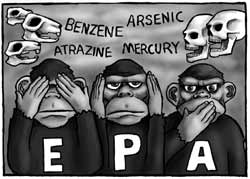Although the Earth Island Institute and Greenpeace responded favorably, and the Sierra Club found some middle ground on the issue, the other organizations–most notably Environmental Defense, the WWF, and the NRDC–made no apology for supporting inhumane, irrelevant animal tests. To the contrary, these organizations continue to actively lobby for more animal testing.
Environmental Defense at the Animals' Expense
Environmental Defense is largely responsible for initiating the EPA's notorious High Production Volume (HPV) chemical testing program. The HPV program was created to pressure chemical manufacturers to test or retest thousands of chemicals using a "checklist" approach.
Even though the animal protection community has reviewed and commented on every proposed HPV test plan in an attempt to limit the number of animal tests performed, Environmental Defense has only recently begun to submit comments on a routine basis and, in virtually all cases, has called for more animal tests–even on substances well known to be blinding and corrosive.
Environmental Defense's executive director, Fred Krupp, responded to PETA's letter on June 1, 2001. He claimed that Environmental Defense "strongly support[s] federal funding of research, development, and validation of non-animal test methods" yet, at the same time, reiterated support for animal testing. According to Krupp's letter, "Environmental Defense believes that animal-testing for the present continues to be a necessary part of chemical evaluation..."
World Wildlife Fund: If You're Not a Panda, You're Out of Luck
Although it has begun to rethink the cruel, unnecessary program, the World Wildlife Fund was largely responsible for initiating and designing the EPA's notorious Endocrine Disruptor Screening Program (EDSP). The EDSP was developed to screen thousands of chemicals to detect endocrine (hormone) disrupting effects–even though scientists cannot even clearly define what an "endocrine disruptor" is or what it does!
The EDSP won't tell us anything about what might happen to people exposed to the chemicals because none of the animal tests has been "scientifically validated" for reliability or relevance to humans. Non-animal tests are now in use in Europe and have proved more effective than the cruel, old-fashioned animal tests.
Nevertheless, WWF officials forged ahead and lobbied Congress to fund the preposterous program. The WWF even tried to keep EDSP planning meetings closed to the public, perhaps to keep people from hearing statements like this one made by a WWF official in response to a statement that one proposed test would kill as many as 3,000 animals each time it was conducted: "I think that what you want to do is terrific!"
In its defense, the WWF says that "in the absence of effective, validated alternatives, [we] believe that limited animal testing is needed for the long-term protection of wildlife and people throughout the world." However, there is nothing "limited" about the amount of animal testing the WWF is endorsing. In fact, the EDSP is the largest animal-testing program of all time.
Fortunately, the WWF took a promising turn after PETA supporter Sir Paul McCartney pressured the organization "to do everything in its power to rectify the situation." Soon after receiving a letter from McCartney, WWF went public with the following statements:
"WWF urges EPA to rely to the fullest extent possible on validated non-animal screens and tests. ...Where such tests are not yet available, WWF believes EPA ought to invest in their development as a matter of priority, and that Congress should increase funding to speed this important transition.
"[W]e believe the figure of 87,000 chemicals listed recently on EPA's website vastly overstates the desirable or likely scope of the EDSP. Instead, we think the program should focus on a sharply reduced number of chemicals that could be on the order of 1-2 percent of that figure [i.e., less than 2,000 chemicals in total].
"WWF believes a number of chemicals have been shown to be sufficiently harmful to warrant imposing bans or severe restrictions on their use now, without need for further tests."
McCartney had also asked WWF to match PETA's $400,000 investment to develop non-animal test methods but, as of this writing, the WWF has not agreed to that request.
National Resource Defense Council: Relentless Pursuit of Irrelevant Tests
Believe it or not, the NRDC did not feel the EDSP was developed fast enough and filed a lawsuit to force the EPA to begin the testing process sooner–without properly validating the animal tests that would be used!
In addition to its ardent support for the EDSP, the NRDC also coordinated a letter calling on the EPA to require that all pesticides undergo developmental neurotoxicity testing (DNT) on animals. The non-validated DNT test involves poisoning rats with toxic chemicals throughout their pregnancy and while they nurse their newborn pups. The pups are then subjected to a series of behavioral tests, after which they are killed and their brains are examined. The test kills between 1,200 and 2,500 animals every time it is performed. Shockingly, EPA officials have publicly admitted that the rat is not "the right model" for humans and that they do not even know how to interpret the results of the DNT.
Despite this, the Children's Environmental Health Network, Consumers Union, the Public Interest Research Group, and the Physicians for Social Responsibility co-signed the NRDC's letter.
By signing the letter, the Physicians for Social Responsibility showed complete disregard for its own advice from its 1999 report, In Harm's Way, which states: "Animal studies of lead, mercury, and PCB's each underestimated the levels of exposure that cause effects in human by 100- to 100,000-fold. Regulatory decisions that rely largely on toxicity testing in genetically similar animals under controlled laboratory conditions will continue to fail to reflect threats to the capacities and complexity of the human brain as well as important gene-environment interactions."
 The EPA: Protecting the Chemical Industry
The EPA: Protecting the Chemical IndustryUnfortunately, the EPA is so addicted to unreliable animal tests that even when evidence from human studies implicates a chemical, the results are ignored. For example, for years human population studies showed that arsenic in drinking water causes cancer, but the EPA spent 20 years dosing animals with arsenic before taking action.
Using its authority under the Toxic Substances Control Act, the EPA has not pulled a single toxic industrial chemical off the market in more than a decade, despite the slaughter of millions of animals in painful laboratory toxicity tests.
Of course, the chemical industry has long approved of the EPA's reliance on animal tests because the results are easily manipulated and required testing means that a company's products are safe from regulation for years while the products undergo testing and retesting on animals.
After decades of practice, industry representatives have perfected the art of arguing both sides of the animal-testing issue. For instance, if a chemical has adverse affects on animals, industry representatives claim that the results aren't applicable to humans. Yet, at the same time, company officials happily display the results of EPA-required animal studies that suggest that their chemicals are not harmful to humans.
The EPA's Fuzzy ThinkingIn addition to the apparent collusion between the chemical industry and the EPA, the EPA's use and view of animal studies is further cause for concern. At a time when European countries are subjecting animal tests to increasing scrutiny and, in the US, the Department of Transportation has approved a non-animal test for corrosivity, the EPA forges ahead with massive animal test plans. The EPA continues to require more animal-based toxicity testing than any other government agency, while spending only a meager fraction of its more than $600 million budget on the development of more humane and scientifically sound non-animal methods.
Yet science has moved far ahead of the EPA. Several of the most common and cruel animal tests–for skin corrosion, irritation, and absorption–are obsolete, and can now be replaced by non-animal alternatives without any threat to public safety. The non-animal tests have all been scientifically validated and/or accepted in other countries whereas the animal tests, ironically, have never been subjected to a level of review that even remotely approximates proper validation.
 Animal Tests and Their Non-animal Animal Alternatives
Animal Tests and Their Non-animal Animal Alternatives
1. Skin Corrosion
Animal test: Rabbits are locked into full-body restraints and a test chemical is applied to the shaved skin on their back. A chemical is considered to be "corrosive" if it eats through the skin, burning away several layers of tissue. No painkillers or anesthetics are provided for this, or any of the other tests listed here.
Non-animal method(s): Chemical corrosivity can now be evaluated using "human skin equivalent" tests, such as EpiDerm® and EpiSkin®, which use artificial skin grown in culture, or using a method called CORROSITEX®, which uses a protein membrane designed to function like skin.
2. Skin Irritation
Animal test: This test is nearly identical to the skin corrosion test, except that experimenters try to find out if the skin damage is reversible (unlike corrosion, which is irreversible).
Non-animal method(s): Once it has been established that a chemical is not corrosive (using one of the non-animal tests above), it is still important to be sure that it does not cause lesser irritation either. Government regulators in Canada accept the use of a skin-patch test in human volunteers as a valid replacement for skin irritation tests on rabbits because it is relatively non-invasive and relates directly to people.
3. Skin Absorption
Animal test: The backs of rats are shaved and a chemical is smeared on for up to 24 hours, after which the skin is washed and the animals are housed in "metabolism cages" to permit the collection of their urine and feces for analysis. Animals are later killed and their skin and blood are analyzed.
Non-animal method(s): An internationally accepted non-animal test for skin absorption measures the passage of a test chemical into and across skin to a fluid reservoir using fresh (from cadavers) or artificial skin. Absorption of a test chemical is measured over time by analysis of the receptor fluid and the treated skin.
But the aforementioned HPV and EDSP test plans are not the only examples of the EPA ignoring more sophisticated non-animal methods in favor of older, and more barbaric, chemical-poisoning tests. For example, the EPA has, in recent years, spent as much as $400,000 on animal toxicity studies at the University of Missouri to test arsenic and lead. Both of these substances, which are present at closed mines, mills, and smelter waste plants, are known to be extremely dangerous to people. It would make sense to order an immediate clean up of such sites. Instead, the EPA is spending tax dollars on animal tests in which the toxins are dissolved in drinking water and food that is then fed to pigs.
Even if the EPA truly believes that more testing for arsenic and lead is necessary, non-animal tests for this very purpose have been available and in widespread use by European countries since 1994. They can be conducted for a small fraction of the cost of animal tests. These "metal bioavailability" tests evaluate the degree to which metal toxins are absorbed through a simulated gastrointestinal tract. Soils containing arsenic, lead, or other metals are "incubated" in an acidic solution that mimics the environment in the stomach. The fraction of lead, arsenic, or other metals that dissolves during the stomach and small-intestinal phases represents the fraction that is available for absorption and which is therefore capable of causing toxicity.
The EPA has also funded hideously cruel mercury inhalation studies, even though the effect of this substance on people is well known. Specifically, the EPA wanted to study in rats what has already been well documented in people–the increased difficulty in conceiving experienced by female dental hygienists who regularly work with mercury. The agency has given the National Institutes of Environmental Health Sciences (NIEHS) $400,000 to subject pregnant rats to mercury vapors. So far, NIEHS toxicologists have not seen the same effect in the animals.
If groups like Environmental Defense, WWF, and NRDC could bring themselves to set aside their addiction to animal testing even for a moment, they would do well to ponder: If the EPA hasn't pulled even a single toxic industrial chemical off the market in more than a decade despite a massive amount of animal testing, what value is there in pushing for more of the same? So while Europeans are enjoying an environment in which dangerous pesticides like atrazine have been banned, we in North America (human and non-human alike) continue to choke on these and other toxins while the EPA does nothing more than "reassess" the well-known hazards of these chemicals in a veritable bottomless pit of animal tests.
As the chemical manufacturers' manipulation of animal test data has shown, results from animal tests may have little or no bearing on people.
Arsenic, for example, was not classified as carcinogenic following animal studies but was later found to cause high levels of lung cancer in smelter workers exposed to arsenic in the air. Similarly, the causal link between benzene and human leukemia was established in 1928, but 14 subsequent animal studies failed to demonstrate this effect.
To further cloud the issue, scientists at an international conference on acute toxicity testing in October 2000 stated that they weren't sure whether the results of acute toxicity tests in rats were even relevant to other rats. (By contrast, a series of four human cell line tests was found to predict human toxicity with 84 percent accuracy.)
Despite our similar capabilities to feel pain physiologically, rats and other animals commonly used in toxicity tests are very different from people. For example, unlike humans, rodents have no vomit reflex. Because they cannot clear toxic chemicals from their bodies in this way, their level of exposure to chemicals is increased, making comparison of rodent test results to humans highly questionable.
Rodents only live for two or three years compared to the average human lifespan of 75 years or more. This is highly significant when considering lifelong toxicity studies. Rats are more susceptible to cancer than humans who, because of our longer lifespan, have developed comparatively more defenses against spontaneous cancers. Likewise, different animal species are born at developmentally different stages, making the results of developmental toxicity studies virtually meaningless with regard to human infants and children.
In addition to differences among animal species, there can also be significant differences between sub-species and among strains of the same species. For example, the chemical ethyl carbamate causes high incidences of cancer in certain mouse strains but not in others. Likewise, chloroform has been found to cause liver tumors in various strains of female mice but not in males.
It should therefore come as no surprise that there have also been numerous cases where animal-based toxicity tests have failed to predict birth defects in humans. For example, a series of disinfectants marketed in Italy under the names Mipaphox, Trichlorphan, and Diptorex caused nervous-system damage in humans and other animals, yet mice in toxicity studies were fed doses of up to 1,500 mg/kg without any apparent negative effects.
Even the conditions under which animals are kept in laboratories can have an impact on the outcome of tests. Factors such as noise, restraint, isolation, pain, psychological distress, overcrowding, bedding materials, regrouping, maternal deprivation, sleeplessness, surgery, and anesthesia can affect every organ and biochemical system in the body.
This evidence of the fallibility of toxicity studies on animals gives many scientists pause. Dr. Joshua Lederberg, Nobel Laureate in Medicine, notes, "It is simply not possible with all the animals in the world to go through chemicals in the blind way we have at the present time and reach credible conclusions about the hazards to human health."
This raises significant questions: What is our reliance on inaccurate animal tests preventing us from learning? Is the EPA missing out on viable ways of protecting people, wild animals, and natural environments by refusing to explore more sophisticated testing methods?
Charitable Giving
As the cliché goes, don't judge a book by its cover. Any organization can stick the words wildlife or environment in its name, but that doesn't mean it's animal- or earth-friendly. Donors should make sure an organization's beliefs and policies are in line with their own before writing a check that may be used to greenwash animal suffering. In the interests of ethics, good science, and the protection of our children, environmental groups must stop demanding that animals be poisoned in laboratories.
•
Heather Moore and Kathy Guillermo are both staff writers for People for the Ethical Treatment of Animals (PETA). Moore is also a regular contributor to IMPACT press.




 The EPA: Protecting the Chemical Industry
The EPA: Protecting the Chemical Industry Animal Tests and Their Non-animal Animal Alternatives
Animal Tests and Their Non-animal Animal Alternatives